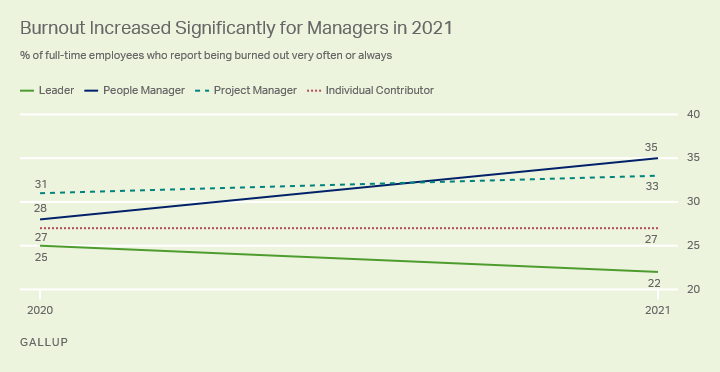Story Highlights
- Managers' stress remained high in 2021 while other groups saw a decrease
- Work-life imbalance continues to plague managers
- Managers need targeted leadership assistance; learn three ways to help
Managers report more stress and burnout and worse physical wellbeing and work-life balance than the people they manage, Gallup has found in recent years.
And based on surveys conducted in 2020 and 2021, manager burnout is only getting worse.
Gallup tracked self-reported burnout at the onset of the COVID-19 pandemic in March 2020 and again throughout 2021. While the percentage of managers who report being burned out "very often" or "always" was slightly higher than that of individual contributors in 2020, the gap widened considerably in 2021.

Having stressed and burned-out managers is never good, but it's a particularly urgent problem right now. Amid the current massive labor market changes, an organization's culture and employment brand matter more than ever in attracting star employees. Forty-eight percent of Americans in the workforce are either actively looking for a new job or watching for openings.
This year, the Bureau of Labor Statistics (BLS) reports record increases in quit rates. Employees most apt to look for new work are either not engaged or actively disengaged in their current workplace.
Having stressed and burned-out managers is never good, but it's a particularly urgent problem right now.
Who is the most important person in your organization for building a culture of high engagement and wellbeing -- the kind that will attract employees in a tight labor market? The manager. But how can managers be expected to improve the engagement and wellbeing of your workforce if they, themselves, are burned out?
Here are possible factors contributing to manager burnout:
- Stress and anxiety levels remained high for managers -- but declined for individual contributors and leaders -- in 2021.
- Diagnosed depression increased for managers in 2021 but was relatively unchanged for individual contributors and project managers and declined for leaders.
- Only one in four managers in 2021 strongly agree that they are able to maintain a healthy balance between work and personal commitments.
Gallup has found that factors leading to burnout can also include unfair treatment at work, unmanageable workload, lack of role clarity, lack of communication and support from one's manager, and unreasonable time pressure.
Here's what your organization can do to reduce manager burnout:
-
Provide clear, ongoing communication from leadership. Managers must implement leadership decisions while motivating their team to get work done.
And currently, concerns about employees' mental and physical health, compliance with vaccine mandates, ongoing changes to where people work, and increases in quit rates -- the "Great Resignation" -- are further complicating the manager's role. Managers can only keep employees informed and engaged if organizational priorities are clear and well communicated as changes occur. Fuzzy or confusing messaging from the top only makes managers' lives more stressful.
-
Manage your managers. Like your employees, your front-line managers and supervisors need to feel they are continuously developing in their work and overall lives. Managers and team leaders need to have coaching conversations with their manager, just as they are expected to do with their employees.
As work and life are now more blended than ever, it is imperative that organizations address and manage not just employee engagement but also the five elements of wellbeing (career, social, financial, physical and community) -- uncovered by Gallup -- to reduce the odds of burnout, stress, worry, anxiety and depression.
Even engaged employees who are not thriving in the five elements have a higher risk of burnout. Organizations can influence the overall lives of their managers with the right strengths-based coaching conversations about their work and overall wellbeing.
-
Upskill your managers through their strengths. You can help make managers' jobs easier by upskilling them to have quality conversations -- at the right intervals -- with their employees that capitalize on their employees' strengths.
Every employee has different strengths and different work and life situations. Managers are in the best position to know each person's tendencies and situation, accommodate each individual, adjust the workflow, motivate high performance, and direct employees to the right wellbeing resources to meet their individual needs within the five elements.
Develop resilient managers who thrive during change:
- Stabilize managers and teams with the Boss to Coach Journey, Gallup's premier manager development program.
- Make manager wellbeing a priority in your organization. We can help.
- Learn the causes and cures of employee burnout.
Line graph showing that burnout increased significantly for managers from 2020 to 2021, from 28% to 35% who report being burned out very often or always





